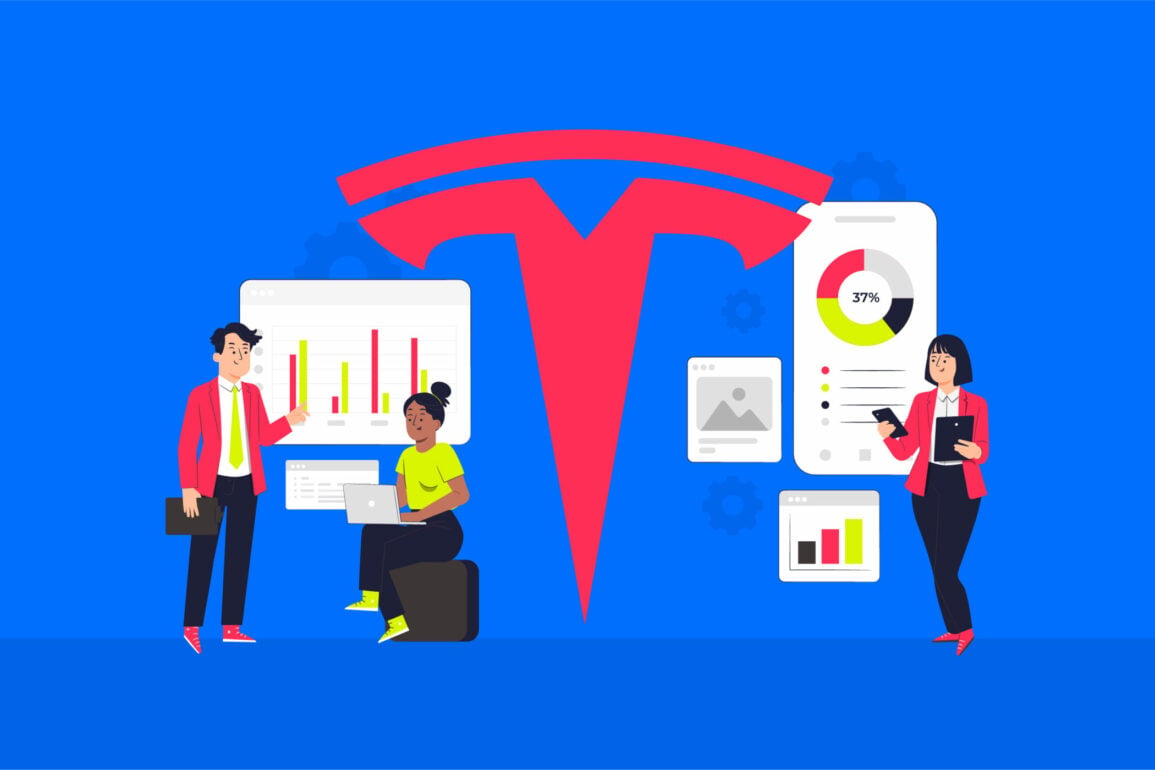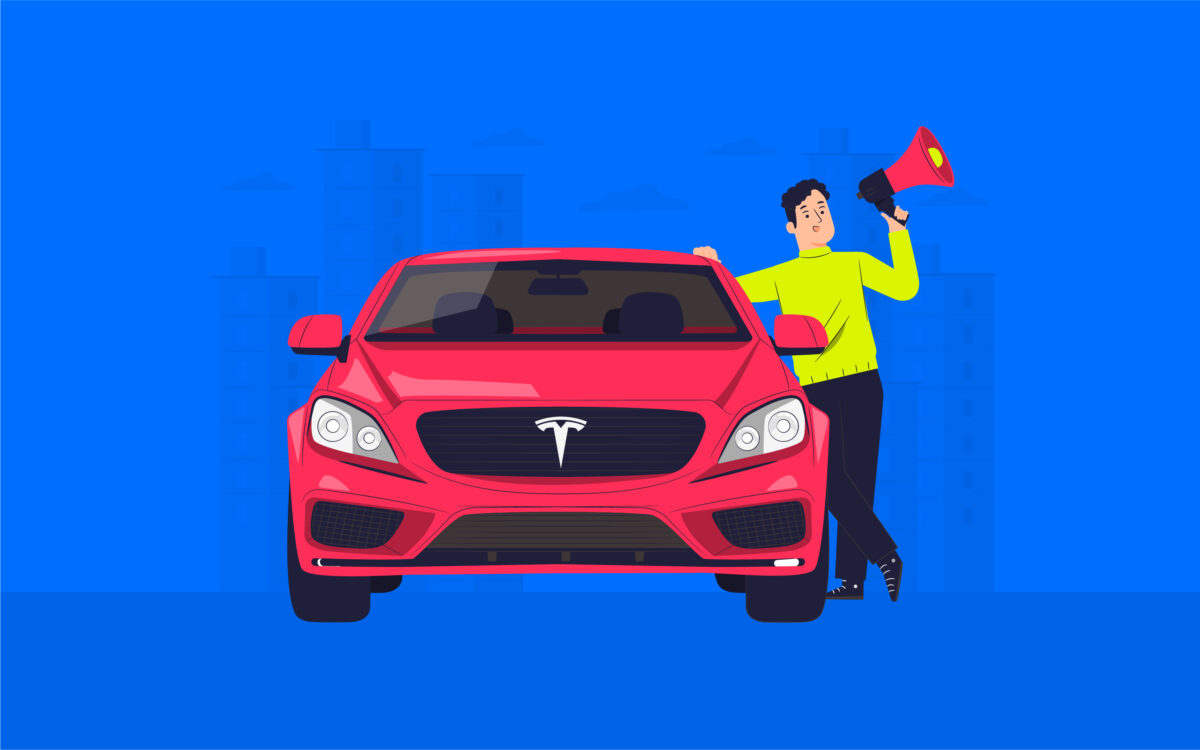Your guide to the Tesla marketing strategy, segmentation, positioning and targeting

The Tesla marketing strategy is easily one of the most interesting in the automotive world. While countless car makers aim to position themselves as innovators and thought leaders in their industry, Tesla takes a unique approach to inspiring and engaging its target customers.
Since the organization launched in 2003, it has been building its image as an original brand, committed to thinking outside the box, exploring new automotive solutions with consistent research and development, and prioritizing customer experience.
With a focus on sustainable energy and eco-friendly production, Tesla’s vehicles naturally grab the attention of conscious buyers.
However, Tesla’s marketing and positioning strategy goes beyond simply standing out as an environmentally-friendly business. Despite having a “zero-dollar” marketing budget, the company has effectively captured a significant market share.
Through carefully planned launch events, a focus on word-of-mouth marketing, and a unique business model, Tesla has quickly become one of the most profitable automotive businesses in the world. Today, we will explore why Tesla’s marketing approach is so effective.
Here’s everything you need to know about the Tesla marketing, positioning, and targeting strategy.
The brand positioning of Tesla: Tesla’s brand positioning
Tesla Motors, owned by Elon Musk, first launched in 2003, focusing on the burgeoning market of electric vehicles, battery storage, and sustainable energy.
At present, the company is one of the world’s most valuable organizations, capturing around 14% of the plug-in automotive market and 21% of the battery-electric vehicle space. At the core of the Tesla brand positioning strategy is a focus on preserving and protecting the planet.
Tesla consistently shares its values in not just its marketing strategies but also the development of solar panels and vehicles which transform the way people think about energy.
However, while sustainability is a critical aspect of the Tesla brand positioning strategy, it’s not the only factor. In today’s competitive market, Tesla cars are pitted against a variety of other solutions from car brands and manufacturers exploring the same sustainable world.
The entire automotive industry is currently undergoing a technological transformation as car manufacturers look for ways to make their products more valuable, sustainable, and intelligent for their target market.
As such, to maintain its presence as a market leader, Tesla needs to be agile and innovative. The company, therefore, invests in regular research and development to not only enhance its products but educate and inspire its buyers.
More than just an innovator, Tesla positions itself as a quirky and creative brand, willing to go beyond the limits of other organizations. It experiments with technologies like autonomous vehicles and has even launched a car into space.
The Tesla brand positioning statement
Tesla’s brand positioning statement focuses on two core values for the company: sustainability and people.
The company is a customer-centric brand with a strong focus on its audience:
“We’re building a world powered by solar energy, running on batteries, and transported by electric vehicles. Explore the most recent impact of our products, people, and supply chain. We design sustainable systems that are massively scalable—resulting in the greatest environmental benefit possible.”
Tesla’s brand promise and branding elements
The CEO of Tesla, Elon Musk, has cultivated a phenomenal branding and marketing strategy. Tesla’s brand positioning strategy, as well as the core essence of the brand, is evident in everything the company does, from sharing content on social media to producing industry events.
Ultimately, the promise of the company is to help create a world where sustainability is a priority. The company is actively building tools designed to minimize the impact human beings have on the planet, exploring the most recent technological innovations at an incredible pace.
Let’s take a closer look at some of the core components of the Tesla brand:
The Tesla mission statement
Tesla’s mission statement is to “accelerate the world’s transition to sustainable energy.”
The company was initially built with a focus on developing eco-friendly and environmentally sustainable products at a time when the world was transitioning to a new way of living. Tesla believes sustainable living should be something we can all accomplish now, not years in the future.
The Tesla vision statement
The vision of Tesla is to create a compelling company for the 21st century by “driving the world’s transition to electric vehicles.”
Though the company’s product development strategy focuses on more than just the automotive landscape, the core focus of the company is on changing the way we travel. Tesla wants to innovate in the creation of the safest, most sustainable transport available today.
Tesla brand values
Though Tesla’s core focus is on the development of sustainable, scalable systems for the automotive and energy landscape, its values go beyond environmental friendliness. The company believes in making products that are not just some of the safest solutions in the world but also inherently fun.
After focusing on safety, Tesla wants to provide customers with products that are compelling and enjoyable to use. The company also believes in keeping its solutions “up to date.” As such, it ensures customers can always access the latest software updates instantly on their devices.
Rapid scalability is another core value for Tesla. The organization operates six huge, integrated factories across three continents, with more than 100,000 employees.
Tesla’s market segmentation: The Tesla target market
The Tesla marketing strategy is based heavily on careful segmentation and a strong understanding of its potential customers. In general, Tesla’s marketing mix positions its core products as too expensive for the average everyday user.
However, Tesla’s approach to marketing ensures it can consistently inspire everyone, not just the people who can afford the latest vehicles.
While the products produced by the Palo Alto brand today may not be affordable for the majority of customers, the brand is committed to creating more accessible vehicles for the general public in the future. In the meantime, it aims to inspire everyone to pursue more sustainable practices.
The typical customers of the brand today are business executives and entrepreneurs who can help position the company as a luxury, authoritative business. Affluent individuals who want to position themselves as tech-savvy and eco-friendly are drawn to the company’s brand.
According to studies into the Tesla target market, most of the company’s customers are males (83.9% male and 16.1% female). They typically have an income of more than $100,000 too.
However, solutions like the Model X (a crossover SUV) aim to attract a wider range of customers due to the affordability factor. This indicates Tesla is planning on expanding its target audience.
Tesla’s target audience: Tesla’s customer segments
Taking a closer look at Tesla’s target audience, we can begin to recognize the careful segmentation strategy used by the brand. Tesla aims to transform the energy economy, making sustainable vehicles more accessible to a wider range of customers.
However, at the moment, electric cars are still a relatively expensive solution for transportation.
Tesla’s marketing strategy is more likely to capture the attention of a relatively niche sector of the overall car market at this time. However, there is scope for prospective buyers to grow.
The Tesla target audience: Demographic segmentation
The average buyer of Tesla luxury cars is an older individual (median age of 54) and usually male. Tesla focuses on appealing to established families, executive professionals, senior managers, and other individuals with a high annual income.
The average income for a Tesla owner is a little lower for the Model 3 compared to the Model X, however.
Tesla customer segments: Tesla’s geographic segmentation
The Tesla marketing strategy positions the company as a global brand. However, the organization does have a higher impact in some areas. Tesla vehicles are popular in North America, Europe, and Asia.
At present, China is one of the fastest-growing geographic segments for Tesla, with sales more than doubling during 2021. However, the US still remains the largest customer segment.
In America, the best states to own a Tesla car generally include Florida, Nevada, California, and Colorado, largely due to the need for strong infrastructure to support electric car use. Tesla vehicles also tend to be popular in sunny states and those with tax structures to support electric vehicles.
Tesla’s target market: Tesla’s behavioral segmentation
Tesla appeals heavily to customers concerned about environmental issues. The prospective buyers for the company are interested in pursuing clean energy, not just to benefit the environment but also to improve their own reputation.
The social status afforded by the ownership of a well-known electric car also drives affluent individuals to make a purchase.
The publicity stunts of the company also help the brand to appeal to younger audiences, with a focus on appearing fun and tech-savvy. However, the majority of Tesla customers are older individuals who are already financially secure.
Tesla market segmentation: Psychographic segmentation
Tesla’s marketing strategy primarily appeals to those who want to be seen as early adopters of technology. As an innovator in its field, Tesla also connects with customers who want to be seen as forward-thinking and original.
Tesla customers are adventurous and image conscious. They’re often highly ambitious, innovative individuals who have a high-earner status and a commitment to protecting the planet.
How does Tesla advertise? An introduction to Tesla advertising
As mentioned above, one of the things that makes the Tesla marketing strategy so interesting is its approach to boosting brand awareness with minimal advertising investment. The company doesn’t typically produce traditional marketing campaigns.
However, this doesn’t mean advertising isn’t a part of the Tesla plan.
Let’s take a closer look at the marketing mix of Tesla:
Product strategy
While other companies introduce products for the automotive industry at a break-neck speed, Tesla is more methodical. The company only has a small selection of vehicles available, which means every new Tesla introduced generally attracts a lot of attention.
Each vehicle is produced with careful research and development strategies. Every car has eco-friendly components to preserve Tesla’s competitive advantage. Additionally, all new Tesla vehicles are designed to enhance user experience with fun and convenient features.
Placement strategy
Franchise owners around the world tend to play a significant role in helping automotive companies thrive. However, this isn’t the case for Tesla. The brand eliminates third-party interaction entirely, making every purchase feel more exclusive.
Tesla makes it harder for people to access its vehicles than other organizations, primarily because it has fewer items to sell. The brand’s market strategy also takes advantage of community and connections, with referral program strategies for consumers.
Pricing strategy
As mentioned above, Tesla vehicles are generally more expensive than even the premium models offered by other automotive brands. Most Tesla model cars cost anywhere from $70,000 to several hundreds of thousands of dollars. However, customers do get exceptional value for money.
While Tesla vehicles are more expensive, high demand for the products hasn’t waned because consumers are drawn to the innovative features and the brand’s impact on their own image. This brand’s advanced tech keeps customers coming back for more.
Promotion strategy
Tesla takes a customer-focused approach to promotion, focusing on building connections with buyers not just through excellent customer service but with a unique personality. The CEO and business visionary for the brand, Elon Musk, plays a significant part in developing brand awareness.
The company’s marketing team and CEO constantly look for new ways to generate buzz without relying on traditional mediums. The company has a strong online presence, with its own YouTube channel and a consistent presence on social networks.
The core elements of the Tesla marketing plan
Tesla has experimented with a host of different and unique marketing strategies over the years, designed to further position the company as an innovator in its field.
From carefully cultivated social media marketing strategies to stunts that generate media buzz, the Tesla marketing strategy is forward-thinking and inspirational.
However, while the marketing department at Tesla is always experimenting, the core components that drive the promotional strategy remain the same: human-centric thinking and innovation.
Here’s how Tesla draws attention to its company:
Innovative designs
Tesla is laser-focused on positioning itself as an original, innovative brand. Every year, it invests billions of dollars in research and development to stay one step ahead of the auto industry.
The company constantly shares its discoveries on social media, through blog post content, and even through videos and events to keep consumers informed.
In recent years, Tesla has introduced everything from more intuitive steering wheel technology to autopilot functionality with AI and more. Plus, customers can also design elements of their Tesla vehicle themselves, styling the car’s interior and exterior to their own tastes.
Community connections
Referral programs are a compelling part of the Tesla marketing strategy. In 2015, the company ran a number of referral campaigns to attract new customers through the promise of incentives. Influencers and promoters also often get involved with these campaigns.
Tesla builds on its referral programs with a strong focus on finding ways to benefit its customers. Tesla gave away 80 new “Tesla Roadster” models to customers for free.
In the years following, the company introduced opportunities to win interesting prizes, like the ability to experience a SpaceX rocket launch or send a photo of yourself into space.
Personalized service
Tesla makes buying your first car as simple and convenient as possible. Not only is it easy to arrange a test drive, but Tesla has its own innovative online sales center, which works to make purchasing vehicles as seamless and convenient as possible.
Additionally, prospective buyers can choose if they want to customize their vehicles before purchase.
Alongside making purchasing easy, Tesla preserves excellent levels of customer satisfaction by delivering phenomenal customer support. The Tesla team offers access to a collection of trained professionals who can deliver repair services to clients anywhere.
Transparency
To keep customers talking about its products and generate a level of trust, Tesla also commits to high levels of transparency.
Not only does the organization keep the public updated with information about its products, work culture, and operations via sustainability reports, but it also releases patents to the public and hosts events too.
Tesla even provides other companies with the opportunity to build on its technology to help further its mission toward achieving sustainability, even if it means compromising on profits.
Word of mouth
The Tesla marketing strategy involves spending as little money as possible on traditional advertising, which means the company relies heavily on word of mouth. Tesla’s publicity stunts regularly capture the attention of both the news and its customers.
As an example, Tesla launched a roaster into space with a rocket via a SpaceX collaboration.
The company has had press members test drive cars and write reviews about them. Plus, Elon Musk is committed to constantly drawing attention to the company on social media.
Musk even responds to tweets and commentary from other customers regularly to highlight his commitment to serving its customers. The company also highlights the feedback and user-generated content of customers regularly in its marketing campaigns.
Strong social media presence
While social media marketing is a common strategy for many organizations, Tesla takes its promotional plan to the next level. The company is one of the most active brands on social channels, including Twitter, which is now owned by Elon Musk itself.
The company uses its social content to draw attention to not just its products but its unique personality.
The brand personality of Tesla is highly influenced by the reputation of Elon Musk himself, who believes in playing a consistent role in the development of the brand. His actions and behavior reflect consistently on the company, for better or worse.
Musk’s online presence has helped to give the company a more human and relatable personality.
The Tesla marketing strategy: Final thoughts
Whether you’re a fan of the Tesla company or not, it’s difficult to deny how impactful its brand positioning and promotion approach has been. The Tesla marketing strategy is among the most interesting in the automotive space.
While the company rarely pays for traditional advertising campaigns, it’s constantly generating buzz online and offline.
The American-based company highlights a sustainable, playful, and adventurous identity throughout its marketing messaging. What’s more, the organization believes in consistently putting its customers first – something that’s evident in everything the business does.
Looking at the marketing strategy of Tesla is a great way for any organization to discover how out-of-the-box thinking can truly transform a company into a true market leader.
Even as new companies emerge on the market with a similar approach to eliminating the use of fossil fuels, Tesla remains one of the most valuable companies in its space.
The clean electric power solutions produced by the business, combined with its innovative attitude and playful personality, make it easy for customers to form connections with the brand.
Fabrik: A branding agency for our times.
Now read these:
—How to name your Tesla: Ideas and facts
—All the companies owned by Elon Musk
—The Tesla logo, its history and meaning

We’ve built our reputation, building brands for other people.
Do you need to bring a new brand to life or breathe new life into an existing one? If so, let’s start a conversation





















